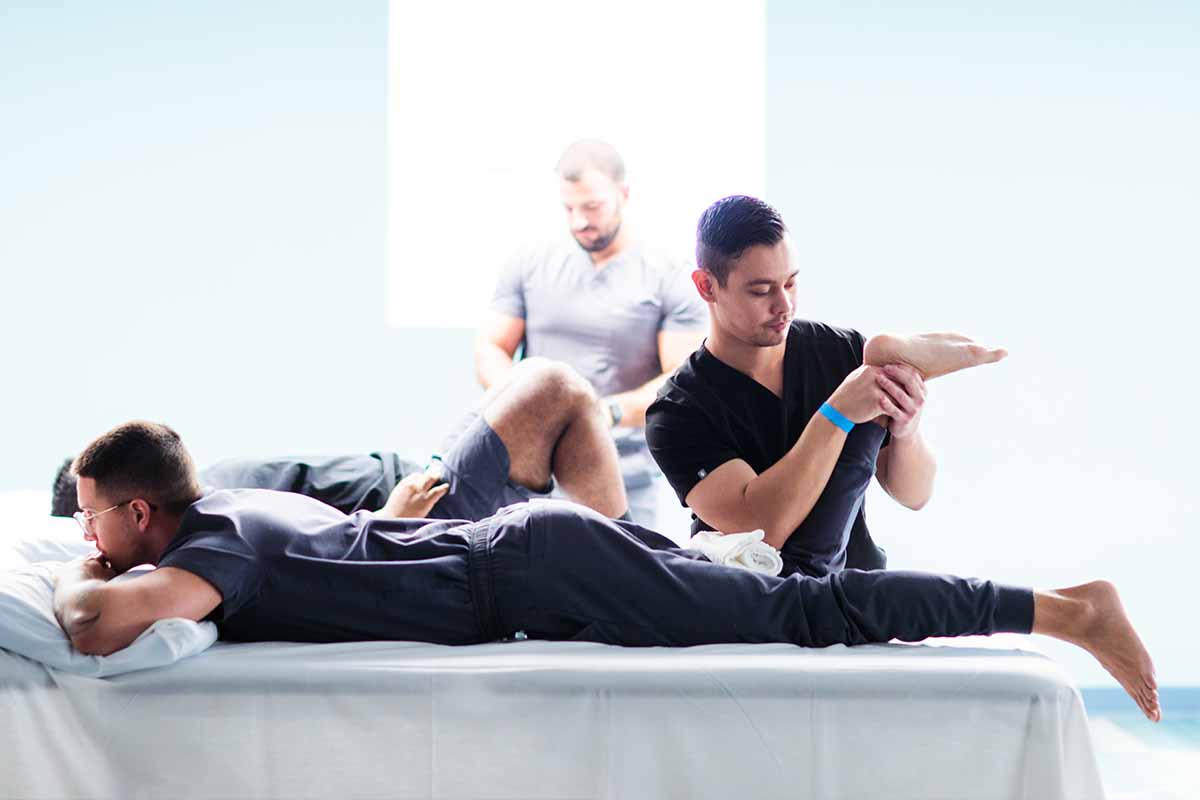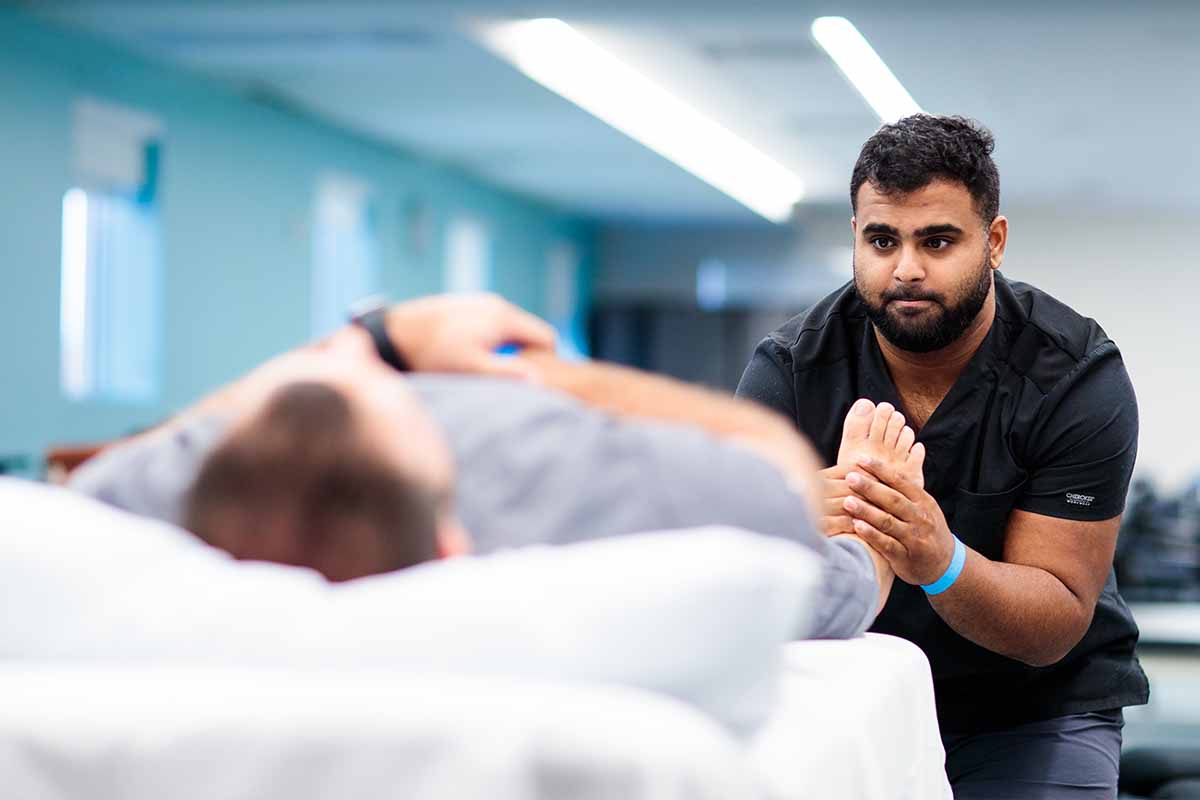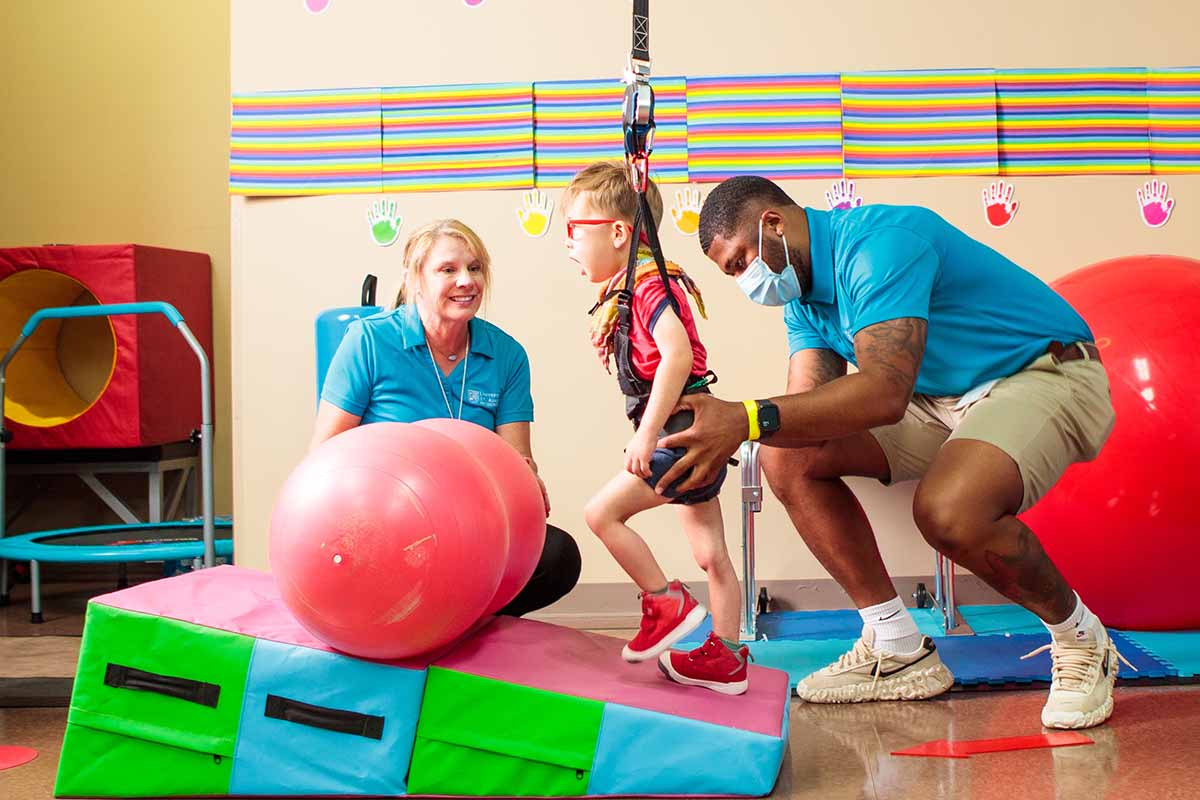Dr. Bourgeois (right) helps fit “Javier” with his new prosthetic leg
Some brands are beloved not only for their excellent products, but also for the way they give back to the community. Ben & Jerry’s, Patagonia, Athleta, and Tom’s of Maine all are certified B Corporations,® a sought-after designation for companies that demonstrate environmental stewardship and social responsibility and that “use business as a force for good.”
Although it’s less common, a university can also earn B Corp™ status from the certifying organization, B Lab.® USAHS is one of those rare universities, preparing future healthcare clinicians, educators, and administrators to be a “force for good” in their careers. USAHS gained B Corp status thanks to values such as:
- USAHS received high marks for governance by female leaders. Its leadership is composed of 73% women, ((USAHS, “USAHS Human Resources. October 2021. )) and its student body is diverse, with at least 37% of students in the Fall 2020 cohort self-identifying as a member of a racial/ethnic minority group. ((USAHS, “USAHS. “2021 Factbook.” March 2021. ))
- Environmental sustainability. USAHS campuses are expanding the use of renewable energy by installing solar arrays and electric car charging stations.
- Faculty and staff are eligible for paid Days of Service each term; in 2018, they completed more than 9,000 hours of community service.
- Community impact. Force for Good awards are granted annually to faculty, alumni, and USAHS partners who are making a tangible difference to students and patients.
But beyond these examples of B Corp values are pro bono clinical experiences, in which students and faculty across graduate programs help patients from underserved communities and make a real difference in their quality of life. From Austin to El Salvador, they are helping patients walk again.
Giving Children, Students Access to Cutting-Edge Therapies
On the USAHS campus in Austin, physical therapy students participate in a truly unique pro bono clinic experience as part of a sixth-trimester class. In the clinic, PT students use state-of-the-art equipment to help kids with neuromotor disabilities practice walking.


DPT students help position Will in the SafeGait harness
As a student in the clinic, Madison Kirkpatrick, DPT ’20, worked with Will, a boy who sustained a spinal cord injury in a car accident. She says that in just one trimester, Will made measurable gains such as greater knee flexion, better balance, more trunk control, and the return of some sensation. “To see a kid go from a freak accident that took away so much of his functioning—to getting some function back while also adapting to his new reality—is a beautiful thing,” Dr. Kirkpatrick says.
“The pro bono clinic was the single best part of my experience at USAHS. It’s so unique to have that in PT school. I’m super grateful that I got exposed to it. It changed what I see for my future.”
“We’re the only university with a Doctor of Physical Therapy program that has integrated this type of pediatric neuroplasticity program into their curriculum,” says associate professor Elizabeth Ardolino, PT, MPT, MS, PhD, who co-leads the PNP. She explains that people with neuromotor deficits can make significant gains by using the SafeGait 360°® Balance and Mobility Trainer®, a harness system that supports the patient’s body weight like a crane as they walk on a treadmill. “The locomotor training with the SafeGait ramps up the excitability of the nervous system,” Dr. Ardolino says. “More neuroplasticity is created, and when we do other activities with the kids that seem like play, the body can learn more and do more.”
“These families have gone through a lot—so many hospital and medical bills,” Dr. Kirkpatrick says. “To have access to this rare, expensive therapy for free; to get care from highly skilled clinicians and from attentive students doing their best—it’s a force for good all around. Every single person involved benefits in multiple ways.”
Helping Underserved Populations Through Pro Bono Clinics
Students and faculty treat people with other health conditions in USAHS’ pro bono clinics, including:
- Patients with Parkinson’s disease. Guided by faculty, physical therapy students plan and lead virtual classes in Rock Steady Boxing, helping people with Parkinson’s disease improve their balance, coordination, and quality of life.
- Populations needing physical and occupational therapy. In a popular class, physical and occupational therapy university students collaborate to treat patients from the local community.
- Children with learning and physical differences. Occupational therapy students help children with learning and physical differences develop their skills through targeted activities.
- People with speech and language disorders. With the support of clinical educators, Master of Science in Speech-Language Pathology (MS-SLP) students provide speech therapy through telehealth to clients of all ages who have speech and language disorders.
Many patients of the pro bono clinics lack health insurance, or they need therapies that their insurance doesn’t cover, so these free services give them access they wouldn’t have otherwise. Some live remotely or have transportation challenges, so the virtual clinics are a good option for them.
In El Salvador, Helping a Man Walk Again
Last winter, a team of USAHS faculty members and clinical simulation staff on our St. Augustine and Miami, Florida, campuses, merged innovation with service to help a man walk again.
Assistant professor Todd Bourgeois, PT, DPT, PhD, organizes twice-yearly “surf & serve” mission trips to the rural coast of El Salvador, in which small groups of physical therapy faculty and students ride the waves and offer pro bono treatments to local patients. In late 2020, the group happened to meet “Javier” (not his real name), a middle-aged toll collector whose leg had been amputated below the knee after an infected cut threatened his life. Javier couldn’t return to work and provide for his family unless he could stand without crutches. He needed a prosthetic leg.
Dr. Bourgeois made a negative mold of Javier’s residual limb with casting material he had brought. He consulted with faculty member Scott Love, PT, DPT, DHS, who is himself an above-the-knee amputee and passionate about helping people with protheses. With the negative in hand, Dr. Love teamed up with adjunct professor Rick Coleman, LPO, CPO, a prosthetist at Bremer Orthotics & Prosthetics in Jacksonville, to make a positive mold. Coleman and Dr. Love had previously collaborated to create a prosthetic device that enables amputees to run outside.
From there, USAHS clinical simulations specialists used the 3D scanner on the USAHS Miami campus to scan the positive, then 3D-printed a socket in nylon material. They reinforced the socket with fiberglass, and Bremer Orthotics donated a high-end foot worth about $5,000.
On his next mission trip with students, Dr. Bourgeois brought Javier’s new leg to him. After a few hours of making adjustments and cutting the pylon to length, the team got the fit almost perfect.
“It was very powerful to see [Javier] walk, to see the tears of joy and gratitude he had,” Dr. Bourgeois says. “He told us in Spanish that he was extraordinarily grateful. He said the leg would give him his life back.”
Dr. Bourgeois cautions, though, that this is just the beginning of Javier’s journey. Javier must navigate rocky terrain from his house down to the level surface of the street, which isn’t easy on a new prosthetic leg. “He needs a lot of rehab. But he seemed highly motivated, which is key. I think this is really going to change his life.”
Dr. Bourgeois gave Javier exercises to help with strength, coordination, and balance. This term, he aims to get students involved in giving follow-up treatments to Javier through telehealth.
Becoming a Force for Good
Faculty like Dr. Bourgeois and Dr. Ardolino not only mentor students through meaningful clinical experiences—they also model the positive impact that practitioners can make. They are training students to be a force for good in healthcare, for patients and the community. “It’s about people with different talents and skills coming together to create something that will serve people, to make the human experience as best as it can be,” Dr. Bourgeois says. “We’re combining forces to create good in people’s lives.”
But service learning is only one facet of how the University embodies the B Corp value of being a force for good. As USAHS board member Ana Lopez-Blazquez, MBA, MHS, puts it, “I am proud to be a part of a university that is a diverse community of human beings who are united around the single purpose of transforming lives through education, wellness, and compassion. That is what we do every day across all of our campuses and beyond our campuses through the work of our esteemed graduates.”
Effective April 28, 2020, the University of St. Augustine for Health Sciences’ Doctor of Physical Therapy program at the Dallas, Texas campus has been granted Candidate for Accreditation status by the Commission on Accreditation in Physical Therapy Education (CAPTE), 3030 Potomac Ave., Suite 100, Alexandria, VA, 22305-3085; phone: 703-706-3245; email: accreditation@apta.org). If needing to contact the program/institution directly specifically about accreditation, please call or email Dr. Thomas P. Werner at 469-498-5740 or twerner@usa.edu. All application-related questions need to be directed to enroll@usa.edu.
Candidate for Accreditation is an accreditation status of affiliation with the Commission on Accreditation in Physical Therapy Education that indicates the program may matriculate students in technical/professional courses. Achievement of Candidate for Accreditation status does not assure that the program will be granted Initial Accreditation.
The Master of Science (M.S.) education program in Speech-Language Pathology at the University of St. Augustine for Health Sciences is a Candidate for Accreditation by the Council on Academic Accreditation in Audiology and Speech-Language Pathology (CAA) of the American Speech-Language-Hearing Association, 2200 Research Boulevard, #310, Rockville, MD 20850, 800-498-2071 or 301-296-5700. Candidacy is a “preaccreditation” status with the CAA, awarded to developing or emerging programs for a maximum period of 5 years.










